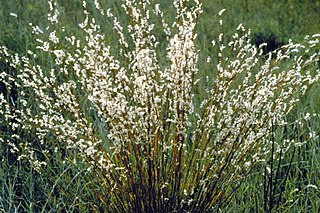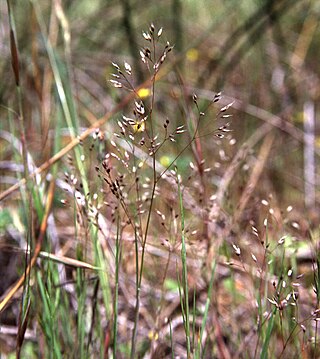
Olmeca is a genus of Mesoamerican bamboo in the grass family.

The Andropogoneae, sometimes called the sorghum tribe, are a large tribe of grasses (family Poaceae) with roughly 1,200 species in 90 genera, mainly distributed in tropical and subtropical areas. They include such important crops as maize (corn), sugarcane, and sorghum. All species in this tribe use C4 carbon fixation, which makes them competitive under warm, high-light conditions.

Aira is a genus of Old World plants in the grass family, native to western and southern Europe, central and southwest Asia, plus Africa.

Poa flabellata, commonly known as tussac grass or just tussac, is a tussock grass native to southern South America, the Falkland Islands, South Georgia and other islands in the South Atlantic. There are also two isolated records from the herbarium at the French Muséum national d'histoire naturelle for the Île Amsterdam in the Indian Ocean.

Panicoideae is the second-largest subfamily of the grasses with over 3,500 species, mainly distributed in warm temperate and tropical regions. It comprises some important agricultural crops, including sugarcane, maize, sorghum, and switchgrass.

Panicum (panicgrass) is a large genus of about 450 species of Poaceae grasses native throughout the tropical regions of the world, with a few species extending into the northern temperate zone. They are often large, annual or perennial grasses, growing to 1–3 m (3–10 ft) tall.

Echinodorus berteroi is an aquatic plant species in the Alismataceae It is native to the southern and central parts of the United States, as well as Central America, the West Indies, and South America as far south as Argentina.

Alopecurus geniculatus is a species of grass known by the common name water foxtail or marsh foxtail. It is native to much of Eurasia and introduced into North America, South America, and Australia. It grows in moist areas.
Scutachne is a genus of plants in the grass family. The only known species is Scutachne dura, it is native to Cuba, Jamaica, and Hispaniola.
Dielsiochloa is a genus of South American plants in the grass family. The only known species is Dielsiochloa floribunda, native to Bolivia, Peru, northwestern Argentina, and northern Chile.
Oplismenopsis is a genus of South American plants in the grass family. The only known species is Oplismenopsis najada, native to southern Brazil, Uruguay, and northeastern Argentina.
Hopia obtusa is a species of grass commonly known as vine mesquite. This plant was treated as Panicum obtusum until recently when more molecular and genetic material revealed new information about it. Hopia obtusa is now placed in the monotypic genus Hopia.

The Stipeae are a tribe of grasses within the subfamily Pooidae, with up to 600 described species.

Bromus pubescens, the hairy woodland brome or hairy wood chess, is a grass species found across much of the eastern and central United States, as well as in Arizona, Québec and Ontario.
Muhlenbergia orophila is a grass species native to Guatemala and to Mexico as far north as the Distrito Federal. The type specimen was collected from an alpine meadow at an elevation of approximately 3750 m near the Summit of Sierra de las Cuchumantanes, a remote mountainous area in el Departamento de Huehuetenango in the western part of Guatemala.

Calamagrostis lapponica, the Lappland reedgrass, is a grass species native to colder parts of the Northern Hemisphere. It has been reported from Scandinavia, Russia, Greenland, Alaska, and every Canadian province and territory except the Maritime Provinces.

Burmannia capitata is a plant species widespread across the West Indies and much of Latin America. It grows in wet areas at elevations less than 100 m. It has been reported from Argentina, Belize, Bolivia, Brazil, Cuba, the Dominican Republic, Haiti, Jamaica, Puerto Rico, Trinidad & Tobago, Colombia, Costa Rica, French Guiana, Guyana, Honduras, southern Mexico, Nicaragua, Panamá, Paraguay, Suriname, Venezuela, and the United States
Altoparadisium is a genus of bunchgrass plants in the grass family. The species are native to Brazil and Bolivia in South America.

Gamochaeta simplicicaulis, the simple-stem cudweed or simple-stem everlasting, is a species of flowering plant in the family Asteraceae. It is native to South America and has become naturalized in Australia, New Zealand, and the southeastern United States.
Cenchrus elegans is a species of plants in the grass family. It is found in Malesia.












